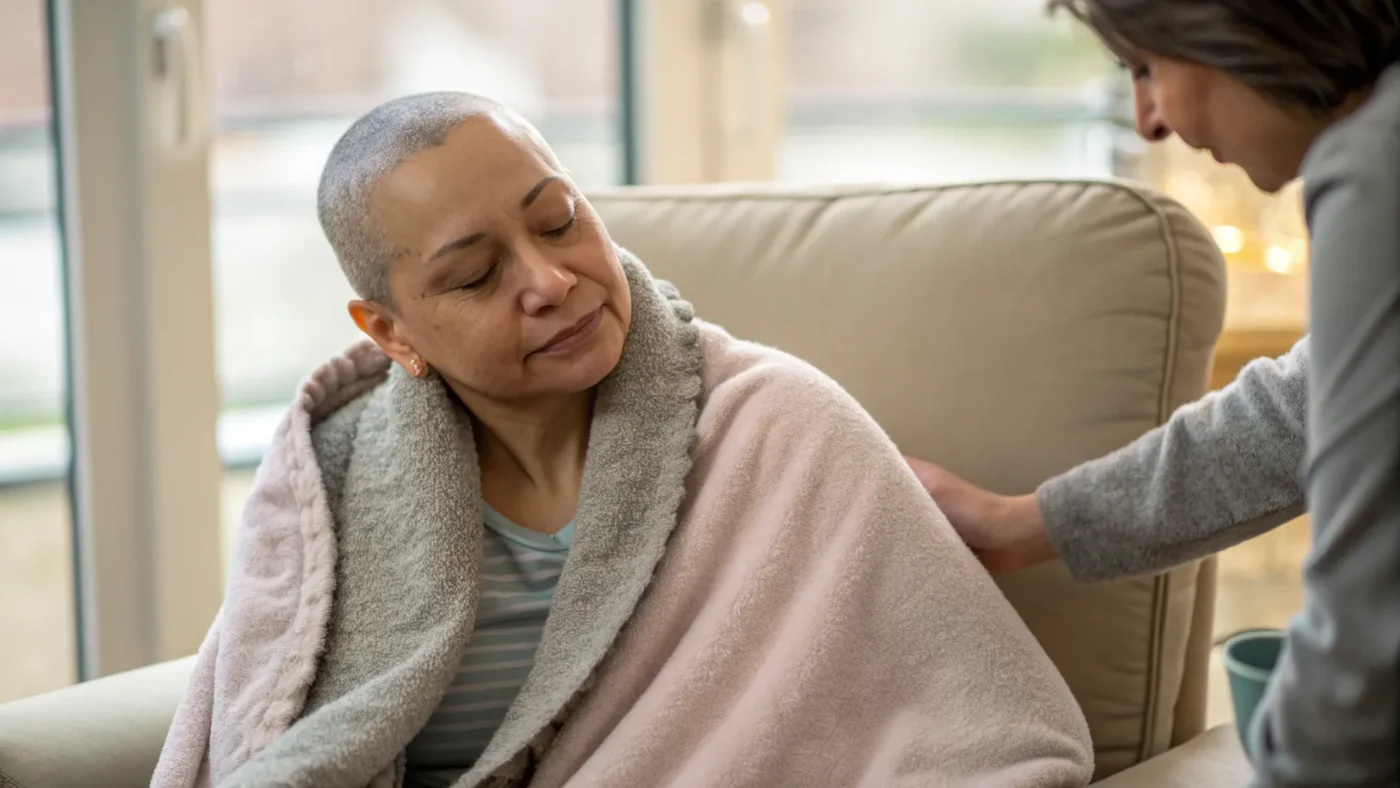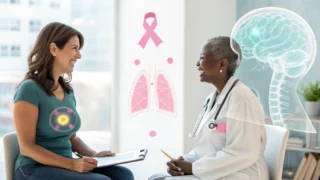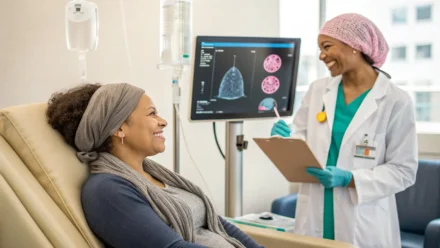I’m part of the team at Cancer Research UK, and in this post I’ll walk you through the general side effects people commonly experience during radiotherapy, what causes them, when they tend to start and improve, and practical ways to manage them. Radiotherapy affects people differently, and while some people notice only mild changes, others find the side effects more challenging. I’ll share clear information, honest patient experiences, and straightforward tips to help you get through treatment and the weeks after.
This guide focuses on the general side effects discussed in our video: tiredness (fatigue), sore skin in the treated area (radiation dermatitis), hair loss limited to the treated area, and the mental and emotional effects that can come with treatment. I’ll also include practical day-to-day advice, what to tell your treatment team, and where to look for further support.
Outline
- How radiotherapy can affect your body
- Tiredness and weakness — causes, timeline, and practical strategies
- Sore skin in the treatment area — what to expect and skin care tips
- Hair loss limited to the area being treated — timeline and care
- Your mental health — dealing with emotions during treatment
- Practical checklist: Dos and don’ts
- When to contact your treatment team
- Recovery timelines and what to expect after treatment stops
- Where to find more information and support
How radiotherapy affects your body
Radiotherapy uses high-energy rays to target cancer cells. While it aims to destroy cancer cells, it inevitably affects some normal cells in the area receiving treatment. Those normal cells start to repair themselves after each treatment session. That repair process uses your body’s energy and resources, which is a key reason many people feel tired or run down during and shortly after radiotherapy.
Side effects usually depend on which part of the body is being treated. For example, radiotherapy to the chest might affect the lungs, while radiotherapy to the abdomen can affect bowel function. But there are a few general side effects that can occur regardless of treatment site — particularly fatigue, skin changes in the treated area, and localized hair loss. Emotional responses are also common and normal.
Understanding the causes and timing of these side effects helps you prepare and manage them more effectively. In the sections below I explain what to expect, share real patient reflections, and provide straightforward measures to help you cope day to day.
Tiredness and weakness (fatigue)
Fatigue is one of the most common and often most distressing side effects of radiotherapy. It is frequently described as an overwhelming tiredness that is not relieved by sleep alone. Unlike everyday tiredness after a busy week, radiotherapy-related fatigue can feel deeper and more persistent.
Why it happens
The main reason for fatigue is the energy the body uses to repair normal cells that were affected by radiation. Immune system responses, inflammation in the treated area, and the psychological stress of cancer and treatment all add to the feeling of exhaustion. Other contributing factors can include changes in sleep, appetite, anaemia (a low red blood cell count), pain, medication side effects, and emotional strain.
When fatigue tends to start and how long it lasts
People often start to notice tiredness within the first few weeks of treatment. In many cases it reaches a peak around the end of treatment or shortly after — the video reflections we captured described fatigue beginning after about four weeks and reaching its worst about two weeks after the end of treatment. For many people, energy then gradually improves over the following weeks to months.
It’s important to know that, while very challenging, this fatigue is usually temporary. Most people begin to feel better within a few weeks to a few months after radiotherapy finishes. Still, everyone’s timeline is different, so don’t be alarmed if your recovery takes longer.
Personal reflections — what fatigue can feel like
“After about four weeks, I started to get tired. The body was starting to weaken. I would tie the day and night, getting up in the morning was like a chore. I couldn’t talk for five minutes. I would just sleep and just sleep and just wake up and sleep again.”
These words capture how relentless and physical fatigue can be. It can affect motivation, memory, and emotion as much as physical stamina. It’s common to need to simplify daily life and to be kinder to yourself about what you can or can’t do each day.
Practical strategies to manage fatigue
There are many things you can try to help manage energy levels. Different approaches work for different people — try a combination and speak with your treatment team about what’s realistic and safe for you.
- Listen to your body and pace yourself: Try to pace activities so you don’t overdo it on better days. Break tasks into smaller steps and spread them across the day or week.
- Prioritise what matters: Choose the tasks that feel most important (like medical appointments, essential chores, or meaningful social contact) and let less necessary things wait.
- Short rests and naps: Short naps can help, but aim to avoid long daytime sleep that disrupts night sleep. A 20–40 minute nap can be refreshing without interfering with nighttime sleep for many people.
- Light exercise: Gentle activity such as a short walk, stretching, or light chair-based exercises can improve energy over time. One patient said: “Just going for them small walks, they really do help you. And even if it is, just walking around your house or just walking around the block.”
- Get outside: Fresh air and natural light often lift mood and energy. Even brief time outdoors can make a difference.
- Sleep hygiene: Keep a regular sleep schedule, create a calming bedtime routine, and make your sleeping environment comfortable and dark. Avoid caffeine later in the day if it affects your sleep.
- Nutrition and hydration: Small, nutritious meals and snacks, with adequate fluids, help maintain energy. Speak with a dietitian if appetite changes or weight loss are concerns.
- Conserve energy: Use labour-saving devices, sit to do household tasks when possible, use a trolley or basket for shopping, and ask friends or family for help with chores.
- Plan activities for your best time of day: If you have more energy in the morning, schedule important tasks then.
- Review medications and underlying causes: Your team can check for treatable causes of extreme tiredness — for example, anaemia or thyroid issues — and may offer interventions.
- Be kind to yourself emotionally: Fatigue is frustrating and can bring emotional ups and downs. Allow yourself to rest without guilt.
When fatigue needs urgent attention
Most fatigue related to radiotherapy is managed with lifestyle strategies and time. But tell your medical team if you have:
- Sudden or severe breathlessness
- Rapidly worsening weakness that limits basic activities (getting out of bed, walking across a room)
- Fever, dizziness, fainting, or other new worrying symptoms
- Symptoms that suggest low mood or depression affecting daily life (see mental health section)
Your team can assess whether there are treatable causes such as infection, anaemia or complications that need attention.
Sore skin in the treated area (radiation dermatitis)
Radiotherapy can cause skin changes in the area being treated. This is sometimes called radiation dermatitis. The effect is limited to the treated area — you won’t get a general rash across the whole body from radiotherapy unless the treatment site is widespread.
How the skin changes
Skin usually starts to show changes around two weeks after starting treatment. It can become red, itchy, sore, dry, and may darken. For some people the skin becomes tender and more sensitive to touch. The severity ranges from mild redness to more marked soreness in a smaller number of people. After treatment, the skin may remain sore for up to two weeks before it begins to recover.
Here’s a snapshot from someone who experienced skin changes:
“After about 10 days, it started to get red on the area that they were targeting and it just progressively got redder and redder. My skin was dry and at the back was just like this triangle shape thing when it was like, okay, I’m all born of colour but it was really, really black. It wasn’t too painful, you know, it was sort of annoying rather than painful.”
Different skin tones can react differently, and the appearance of changes will vary. The important points are that the reaction is local and that it usually resolves after treatment stops, though it may take a few weeks to improve fully. In most cases, there is no permanent scarring.
Skin care: what to do and what to avoid
At the start of treatment we generally advise continuing your normal skincare routine. As the skin becomes more sensitive, your radiotherapy team will let you know which products are safe to use on the treated area.
General practical tips:
- Gentle cleansing: Use a mild, fragrance-free soap or cleanser. Be gentle: don’t scrub. One patient described their routine: “When I’m washing myself, use a sponge and you’re just literally as it were just squirt it down you don’t rub the skin at all because it’s already damaged, pat dry, don’t rub.”
- Pat dry, do not rub: Use a soft towel and gently pat the area dry after washing.
- Use recommended creams: Your hospital may recommend a specific cream or emollient to soothe the skin — use what they suggest. A patient noted, “I spoke to the hospital about it and it was them that recommended this cream to put on just to alleviate the symptoms.”
- Wear loose, soft clothing: Choose breathable natural fabrics like cotton that won’t rub the treated area. Tight or rough clothing can irritate sensitive skin. Another patient said, “I had to change most of my wardrobe and wear cotton. Wearing t-shirts, soft clothing, nothing that would rub.”
- Protect from sun and wind: Keep the treated area covered outdoors. Sun exposure can worsen skin reactions, and wind can dry and aggravate sensitive skin. Use scarves, hats, or loose long sleeves to shield the area.
- Avoid harsh products: Avoid perfumed products, deodorants, or harsh chemicals on the treated area unless your team says it’s okay.
- Avoid hot baths or saunas: Very hot water can irritate sensitive skin. Warm showers are better.
Clothing and practical adjustments
Simple wardrobe changes can help comfort and speed recovery. Choose loose-fitting, soft, breathable clothing that does not rub the treated area. If the skin on your scalp or chest is sensitive, soft cotton headscarves, hats, or T-shirts can be both practical and comforting.
As one patient put it: “It’s important when you go outside to make sure that you do wear that head scarf or you do wear a hat or whatever it is. I wouldn’t go in this on at all at all because my skin was, I know it was too delicate.”
When skin reactions are more serious
Most skin changes are manageable at home with gentle care and the advice of your radiotherapy team. Contact your team if you notice:
- Severe blistering, open sores, or broken skin
- Signs of infection such as increasing pain, warmth, pus, or fever
- Severe pain or discomfort not controlled by simple measures
Your team can provide dressings, prescriptions, or adjustments to your skin care plan as needed.
Hair loss limited to the treated area
Radiotherapy can cause hair loss only in the area that receives the treatment. This is different from many chemotherapy treatments, which can cause hair loss across the whole body.
What to expect
Hair loss usually begins a few weeks after the start of radiotherapy — for many people around two to three weeks. It may come out gradually or in clumps, and you may notice more hair on brushes or pillows. For example, one person said: “Two to three weeks after the radiotherapy, I was brushing my hair and loads came out on the brush. I knew it was going to happen, but it was just hard when it happened.”
In most cases, hair regrows after radiotherapy finishes. Regrowth timelines vary — some people see hair returning within a couple of months, while for others it may take longer. When hair returns, it can sometimes be a slightly different colour or texture.
A patient reflection captures this reality: “Mine did grow back and there’s a lot of grey in it, so I have to dye it. This is not my original colour. It’s very slow growing back.”
Looking after your scalp and regrowing hair
Gentle scalp care helps while hair is thinning or regrowing.
- Use gentle, fragrance-free cleansers: Mild soaps or baby shampoos are often recommended. One straightforward tip: “Use the simple soap to clean the area, be gentle with the skin in that area and after washing, pat the area dry with a soft towel.”
- Avoid harsh hair treatments: Avoid hair dyes, perming, bleaching, or heat styling until your team says the scalp has recovered enough.
- Cover the head if needed: Use a soft hat, scarf, or wig if you prefer not to show hair loss. Many people find scarves a comfortable, lightweight option, especially in warm weather.
- Wig options and support: If hair loss affects your confidence, talk to your treatment team about wig services, financial help, or local charities that provide wigs. Some hospitals have wig fitting services and can refer you to suppliers.
- Patience with regrowth: Hair texture and colour can change temporarily; give it time to return and consult your team if you have concerns.
Emotional impact of hair changes
Hair loss — even when limited to the treated area — can have a strong emotional impact. It may affect how you feel about your appearance and contribute to low mood or lowered confidence. These reactions are normal and valid. Combining practical scalp care with emotional support can be hugely helpful; see the mental health section for more.
Your mental health during radiotherapy
Treatment for cancer is not only physical — it affects emotions, relationships, and day-to-day wellbeing. Radiotherapy can bring a complex mix of feelings: relief that treatment is underway, anxiety about side effects, frustration at limitations, and moments of sadness or anger. These reactions are normal; many people find that talking about their experience makes it easier to cope.
Common emotional experiences
People commonly describe:
- Sadness or low mood
- Anxiety or worry about treatment outcomes
- Frustration at losing independence or energy
- Periods of crying without a clear reason
- Loss of confidence in their body or appearance
A patient shared: “I felt frustrated. Some days were really, really challenging where there were just tears without words. It’s a mixture of emotions. You feel angry and you feel frustrated. you lose your confidence.”
Practical approaches to support emotional wellbeing
There are many helpful approaches and supports available:
- Talk about how you feel: Share your feelings with friends, family, or your treatment team. Sometimes simply naming emotions reduces their power.
- Professional counselling: Many hospitals can refer you to counselling services. One patient said, “I refer from the hospital with counselling which I attended for about a year.”
- Peer support and online forums: Speaking with others who have been through similar treatments can reduce isolation. Our video participants described how helpful forums and peer conversations were: “I went on loads of different forums and I spoke to loads of different people and it really, really helped me.”
- Complementary therapies: Some people find therapies like massage, relaxation classes, or gentle yoga useful. Discuss options with your team to see what’s appropriate.
- Mindfulness and stress-reduction techniques: Short daily practices, breathing exercises, or guided meditations can lower anxiety and improve focus.
- Maintain social contacts: Even short chats with people who care about you can be uplifting.
- Set small goals: Achievable daily goals can help maintain a sense of control.
When to seek extra help
If low mood, anxiety, or feelings of hopelessness are persistent or interfering with daily life (sleep, eating, relationships, caring for children), reach out to your medical team. Depression and anxiety are common and treatable, and your team can refer you to specialist services, medication if appropriate, or other supports.
Support from your treatment team
Your radiotherapy team are there not just for the technical aspects of your treatment, but also to advise about side effects and support services. A patient reflected: “I couldn’t praise the team highly enough. Everybody that was involved were unbelievable. And if it hadn’t been for them, I just don’t think I would have gotten through with it.”
Ask your team about local services such as:
- Counselling and psychology services
- Support groups and peer mentoring
- Complementary therapy offerings in the hospital or community
- Social workers or financial advice services if needed
Practical day-to-day tips — a checklist
Below is a practical checklist you can use during radiotherapy. It pulls together the key tips from the sections above into simple, actionable steps.
Daily energy management
- Plan and prioritise: choose 2–3 things to focus on each day.
- Pace yourself: do short bursts of activity with rest breaks.
- Include a short walk each day if you can — even indoors or around the garden.
- Keep hydrated and eat small, nutritious meals/snacks regularly.
- Allow short naps but try to protect your night-time sleep schedule.
Skin care
- Start by using your normal products unless advised otherwise.
- Use mild, fragrance-free soaps or cleansers; be gentle — don’t rub.
- Pat the area dry with a soft towel; avoid vigorous drying.
- Apply emollient creams recommended by your team.
- Wear soft, loose-fitting clothing and protect the area from sun and wind.
Scalp and hair care
- Use gentle shampoos and avoid harsh chemical treatments during and for some time after treatment.
- Pat the scalp dry gently rather than rubbing.
- Consider a soft scarf or hat for comfort and sun protection.
- Ask about wig services if hair loss affects your confidence.
Emotional wellbeing
- Talk to someone you trust about how you’re feeling.
- Ask your team about counselling and referral options.
- Try relaxation techniques and short periods of mindfulness each day.
- Use online or local peer support forums to connect with others.
What to tell your radiotherapy team
Be open with your treatment team about how side effects affect you. They can tailor advice, adjust medication, or provide referrals. Key things to report include:
- Severe tiredness affecting daily tasks or causing sudden decline
- Worsening skin changes, blistering, broken skin, or signs of infection
- Severe pain in or around the treated area
- New or worsening emotional symptoms such as severe anxiety or depression
- Any other symptom that is worrying or unusual for you
Your team will appreciate hearing specifics — when symptoms started, how they affect your day, and what you’ve tried so far to manage them.
Recovery timelines — what to expect after treatment
The good news is that many general side effects start to improve once radiotherapy ends. While there’s no single recovery timeline that fits everyone, the following general guidance is useful:
- Fatigue: Often starts within the first few weeks of treatment, peaks around the end of treatment or shortly after, and then gradually improves over several weeks to months. Many people notice meaningful improvement within two months after finishing radiotherapy.
- Skin changes: Usually begin around two weeks into treatment, may continue to worsen slightly during treatment, and generally begin to improve within two weeks after treatment stops. Complete recovery of the skin can take several weeks longer.
- Hair regrowth (in the treated area): Hair often starts to regrow within a couple of months after treatment finishes but may take longer. Texture or colour can be different at first.
- Emotional recovery: Emotional healing takes time and varies for each person. Counselling, support groups, and gradual return to normal activities can speed emotional recovery.
One patient’s experience is worth repeating: “It’s not forever. You’re not going to be like this forever and I did have to tell myself that. Two months after treatment I started to feel less tired and that was a way forward because things start to really improve.”
When to get urgent help
While most side effects are manageable, some symptoms need prompt medical attention. Contact your treatment team or GP urgently if you have any of the following:
- High fever or signs of infection
- Severe, sudden breathlessness
- Rapidly worsening weakness or inability to move normally
- Severe skin breakdown with bleeding, pus, or extreme pain
- New neurological symptoms such as sudden severe headache, confusion, or seizures
If you are unsure about the urgency of a symptom, it is better to check with your treatment team or seek emergency care — they can help decide the next steps.
Support options and where to find more information
Your radiotherapy team can point you to local patient support services, which may include:
- Counselling and psychological support
- Complementary therapy programmes (massage, relaxation, acupuncture where appropriate)
- Support groups and patient forums
- Practical services such as transport, financial advice, or help at home
There’s also a wealth of reliable information available from cancer organisations. These resources cover detailed guidance on side effects, skin care, hair loss, and emotional support. If you want a trustworthy first place to read more, the Cancer Research UK information pages explain radiotherapy side effects in plain language and list local support options.
Final reflections and encouragement
Facing radiotherapy can be physically and emotionally demanding. The general side effects — fatigue, skin changes, hair loss in the field of treatment, and emotional ups and downs — are common, predictable, and, importantly, usually temporary. You’re not alone in this.
“If you get a bit cranky or if you’re being a bit low, go for it. There’s so much help out there and the form pushing forward like, don’t sit down in silence, it’s the same thing, just get help you need.”
Listen to your body, accept help, and use the team around you — that includes doctors, nurses, hospital support services, friends, and peers who understand what you’re going through. Small practical steps — a short daily walk, gentle skin care, soft clothing, short rest breaks, and talking about how you feel — can make a big difference from day to day.
Remember these key points:
- Fatigue is common: It usually starts during treatment, may peak around the end of treatment, and generally improves in weeks to months.
- Skin reactions are local: They affect only the treated area and are often manageable with gentle care. Protect the area from sun and wind.
- Hair loss is usually local: Hair in the treated area may fall out but often regrows, sometimes with temporary changes in colour or texture.
- Emotional reactions are normal: Talk to your team, ask for counselling if you need it, and consider peer support forums and complementary therapies.
If you have symptoms or concerns not covered here, please bring them up with your radiotherapy team — they’ll provide tailored advice and reassurance. Many people told us that talking, asking for help, and accessing the services available made the whole process much easier to bear.
“I couldn’t praise the team highly enough. Everybody that was involved were unbelievable. And if it hadn’t been for them, I just don’t think I would have gotten through with it.”
We hope this guide helps you feel more prepared and supported during radiotherapy. If you want to read more in-depth information or find local support services, look for reliable resources provided by Cancer Research UK and other established cancer support organisations. And above all, be gentle with yourself — recovery is a process, and taking small steps each day adds up.
Further reading and next steps
When you feel ready, speak with your radiotherapy team about personalised tips for your situation. They can advise on specific creams, recommended shampoos, wig services, counselling referrals, and when to get urgent help. Use this guide as a starting point for conversations with your care team and your support network.
You’re not alone in this. Reach out, accept help, and take things one day at a time.











Leave a Comment